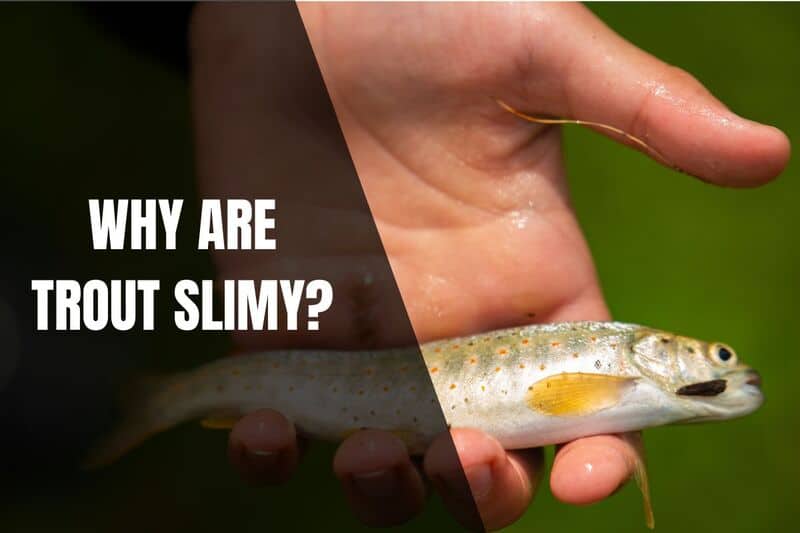The slimy layer on the outside of trout ensures that the fish is able to survive in the wild.
The slime is a mucus secretion that protects the fish from infections and parasites, as well as aids in the fish’s ability to swim through fast water.
It’s important to remember that whenever handling a trout, always make sure to wet your hands before picking up the fish.

Is It Normal for Trout to Be Slimy?
Every fish on the planet secretes some form of mucus coating in order to protect their scales and skin.
It is completely normal for a trout to be slimy because that slime is important to ensure the fish’s survival.
Its number one purpose is, of course, to help lubricate the body, making it easier for the fish to swim in fast water. It also protects the fish from parasites, bacteria, fungi, and ectoparasites.
What Is the Slime on Fresh Fish?
The slime that is found on virtually every species of fresh fish is actually a mucus that is secreted from the body. It serves the purpose of protecting the fish in fairly the same manner that human mucus protects an angler. Although the mucus that is secreted from humans is quite different from that which is secreted from a fish, it nevertheless serves as a protective layer.
Unlike humans, whose mucus is generally found in the mouth and nose, a fish’s slime completely encapsulates their body in order to help them heal from injuries, as well as protect them from parasites, bacteria, and more.
Should Fresh Fish Be Slimy?
The first reaction that any new angler has when they come in contact with the fish is to wipe their hand dry.
In fact, many people won’t even go fishing simply because of the slimy layer. Virtually all fish species have some form of slime that protects them from infections, improves their ability to swim through the water, and even helps them to maintain a balance of electrolytes within the body.
Why Are Trout Slimy?
Whether you call it slime or snot, all fish, including trout, are covered with a mucus layer that serves a number of important purposes.
That layer of slime plays an integral part in the survival of the fish, as it not only reduces drag as the fish swims through the water but also helps to protect it from parasites and diseases.
Balances Essential Electrolytes
Just like human beings, even fish need to maintain a steady balance of important electrolytes. When an angler is fishing out in the hot sun, their body sweats and, as a result, lose electrolytes.
Eventually, an angler will need to consume a beverage to help balance out the essential electrolytes within the body.
Fish are no different, and the main way in which a trout balances essential electrolytes is through that slimy layer. It effectively functions as a two-way filter that allows the exchange of electrolytes between the fish and the water.
Protection from Parasites
The slime on a trout serves many important purposes, but nothing is more important to the survival of the fish than protection from parasites. That slimy layer that encapsulates a trout is its main line of defence against fungi, ectoparasites, as well as bacteria.
It contains a medicinal quality that helps to soothe any open wounds and also assists in speedier recovery from injuries.
In fact, the slime on a trout is so effective at protecting the fish that medical researchers are even trying to isolate the ingredients in that slime in order to find potential applications for human use.
Reduces Drag
Long before anyone realized the important role that the trout slime plays in protecting it from parasites and balancing electrolytes, it was always anticipated that the number one use for the slime was to reduce friction and drag when swimming in the water.
It is important to remember that the surface of the trout is covered in scales, which are rough. A rough surface flowing through water creates a lot of drag.
When that rough surface is covered by a thick slimy layer, it creates a smoother surface allowing the fish to swim effortlessly.
How Do You Handle A Slimy Trout?
Many new anglers do not understand how to handle a slimy trout.
It’s not uncommon to see beginners along rivers, wiping their hands dry before pulling the fish out of the water. In order to ensure the trout’s best chance of survival after a catch and release, it’s important to know and understand how to handle a slimy trout properly.
That slimy substance serves as a protective layer, encapsulating the fish’s skin and preventing disease and parasites.
When an angler picks up a slimy trout with dry hands, that slimy layer is wiped away, leaving the fish vulnerable to infections. Whenever you plan on handling a trout, make sure to wet your hands before picking the fish up out of the water, and never pick it up by the fishing line.
Can You Handle Trout with Dry Hands?
At no time should you ever attempt to handle a live trout with dry hands!
The slime on a trout is there for protection, and when handling the fish using dry hands, the hands can act as an abrasive, rubbing off the slime instead.
When working with a freshly caught trout, it’s important always make sure to wet the hands before ever touching the fish. Picking up a trout with dry hands is a death sentence for the fish.
